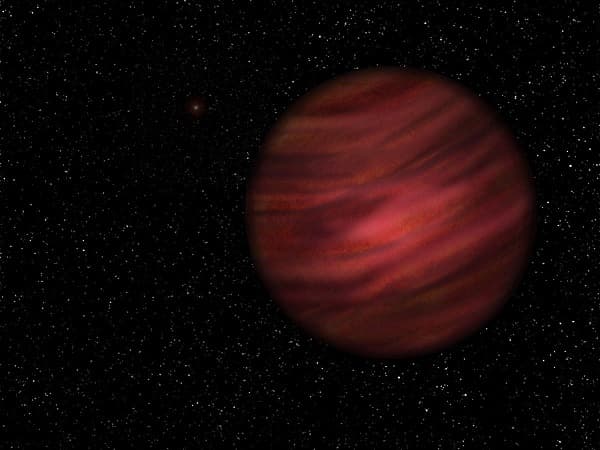Planet's Orbit Found A Trillion Kms Away From The Sun - Meet the Widest Known Planetary System
The efforts of British, American, and Australian scientists have all taken fruit to discover what is believed to be the widest known planetary system. Their studies show that the 2MASS J2126-8140 isn’t the orphan free-floating planet it was believed to be; it does have a parent in the TYC 9486-927-1.
The 2MASS J2126-8140 was discovered some eight years ago by US based researchers in an infrared sky survey. It's mass and age were subsequently determined; it was not heavy enough to tagged a failed star and therefore was concluded to be a free-floating or a rogue planet. The TYC 9486-927-1 has also long been identified. It was considered young, but no substantial evidence was found by which it could be put into a group of other stars or be looked at as part of a solar system.

Locate the star in the image.
Dr. Niall Deacon of the University of Hertfordshire and his team have now, after years of extensive search and research, provided a link between the two. The objects are both 104 light years away from the earth. Also, they are moving through space together, i.e., in the same direction. This shows they are associated; and the scientists have been successful in establishing that this association can be extended to a planet-star relationship.
By studying the spectra of the bodies, Deacon’s team could measure the amount of lithium present in TYC 9486-927-1. Since lithium burns over a star’s lifetime, the amount present indicates the age. TYC 9486-927-1 had more lithium than a nearby 45-million-year old star group called the Tucana Horologium Association, but less than another group of stars 10 million years old. These couple of comparisons give an approximate estimate of their ages.
It is certainly a long distance relationship between the two, and this is where the element of surprise lies. The star is a trillion kilometres away from the planet. In simpler terms, that is around the 6900 times the distance between the Sun and the Earth. At such enormous distance, it takes the planet as many as 900,000 earth years to complete an orbit.
Incorporating the known values of orbit and age, it can be said that the 2MASS J212-8140 has made only 50 circles about its star. The extreme numbers have also lead to doubts about how such a far-flung planetary system could have formed.
Source: #-Link-Snipped-#
The 2MASS J2126-8140 was discovered some eight years ago by US based researchers in an infrared sky survey. It's mass and age were subsequently determined; it was not heavy enough to tagged a failed star and therefore was concluded to be a free-floating or a rogue planet. The TYC 9486-927-1 has also long been identified. It was considered young, but no substantial evidence was found by which it could be put into a group of other stars or be looked at as part of a solar system.

Locate the star in the image.
Dr. Niall Deacon of the University of Hertfordshire and his team have now, after years of extensive search and research, provided a link between the two. The objects are both 104 light years away from the earth. Also, they are moving through space together, i.e., in the same direction. This shows they are associated; and the scientists have been successful in establishing that this association can be extended to a planet-star relationship.
By studying the spectra of the bodies, Deacon’s team could measure the amount of lithium present in TYC 9486-927-1. Since lithium burns over a star’s lifetime, the amount present indicates the age. TYC 9486-927-1 had more lithium than a nearby 45-million-year old star group called the Tucana Horologium Association, but less than another group of stars 10 million years old. These couple of comparisons give an approximate estimate of their ages.
It is certainly a long distance relationship between the two, and this is where the element of surprise lies. The star is a trillion kilometres away from the planet. In simpler terms, that is around the 6900 times the distance between the Sun and the Earth. At such enormous distance, it takes the planet as many as 900,000 earth years to complete an orbit.
Incorporating the known values of orbit and age, it can be said that the 2MASS J212-8140 has made only 50 circles about its star. The extreme numbers have also lead to doubts about how such a far-flung planetary system could have formed.
Source: #-Link-Snipped-#
Replies
You are reading an archived discussion.
Related Posts
Project Abstract / Summary : The 21st century is the era of “Smart”. With the advancement in technology and engineering, our daily use gadgets are getting smarter. Even our cars...
Project Abstract / Summary : The 21st century is the era of “Smart”. With the advancement in technology and engineering, our daily use gadgets are getting smarter. Even our cars...
An amazing co-ordinated display by the Italian Police:
Project Abstract / Summary : The project aims at the optimization of CNC turning operations when used over Oil Hardened Non-Shrinking Steel (OHNS) material considering Depth of Cut, Cutting Speed...
Researchers from the Institute for Human and Machine Cognition, Florida, have programmed Google’s Atlas robot to perform household chores such as picking up trash and vacuuming.
The Atlas, which was...
